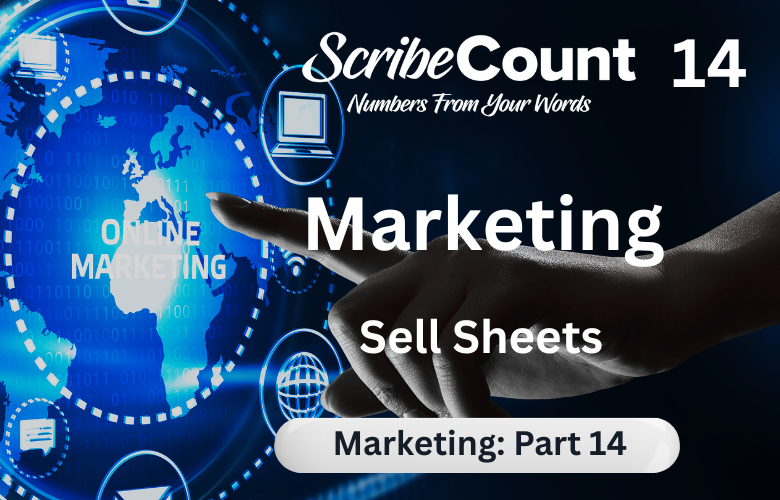Sell Sheets for Indie Authors: Reaching Retailers with Professional Tools
For indie authors, successfully placing books in bookstores, libraries, and retail outlets requires more than just a good story. It demands professionalism, marketing savvy, and the right materials to pitch your product persuasively. One of the most essential tools for this purpose is the sell sheet. Also known as a sales flyer or one-sheet, the sell sheet is a concise, visually appealing document designed to sell your book to a buyer, distributor, or event coordinator.
Unlike consumer-facing marketing materials, sell sheets are geared toward industry professionals. They're meant to communicate value and logistics: what your book is about, who it's for, how it can be ordered, and why it's worth shelf space. In this guide, we’ll explore what goes into an effective sell sheet, how to use it strategically, and how to target the right people with it to increase your print book sales.
What Is a Sell Sheet and Why Do Authors Need One?
A sell sheet is a single-page snapshot of your book that acts as a pitch to bookstores, libraries, media contacts, wholesalers, and event organizers. It introduces your book and author brand while providing key publishing data like the ISBN, distributor, pricing, and availability. Think of it as a professional handshake, opening the door for more serious acquisition discussions.
Authors use sell sheets in a variety of outreach scenarios. They're emailed to booksellers, included in bookstore mailers, handed out at trade shows, or even brought to local shops in person. They can also be used as part of event applications or library purchasing packets. Sell sheets give potential buyers all the key info in one professional, persuasive document.
Essential Elements of an Effective Sell Sheet
Your sell sheet must include specific information needed by industry buyers. This includes the book title, author name, cover image, genre, comparable titles, a short hook or blurb, key metadata, and ordering details. For bookstores and libraries to consider your title, it should also clearly list:
- ISBN
- Trim size and page count
- Retail price
- Publisher
- Distributor (Ingram, Baker & Taylor, etc.)
- Available formats (paperback, hardcover, audiobook)
- Returnability and wholesale discount terms
These technical specs are just as important as your cover art and plot summary. They help decision-makers determine whether your book fits their inventory system and ordering process.
Targeting the Right Audience
Sell sheets are designed for gatekeepers—bookstore buyers, librarians, wholesale acquisition managers, and event organizers. These are professionals who want quick, clear, actionable information. Your job is to make it easy for them to say yes. That starts with identifying the right targets.
Find your ideal retailers based on your genre and format. If you write inspirational nonfiction, you may have success with independent Christian bookstores. YA fantasy authors might do well with comic book shops or local chains that support teen lit. For libraries, seek out state reading lists, genre-specific consortia, and county library systems that accept indie-published work.
Use services like IndieBound, LibraryThing, and American Booksellers Association to build lists. You can also use data aggregators, publisher directories, or mailing list services like BookMailer to reach curated bookseller lists.
How to Create a Sell Sheet
Design matters. A clean, readable layout with a balanced mix of text and images helps your sell sheet look professional. You can create your own using tools like Canva, Adobe Express, or BookBrush. Many of these platforms offer templates tailored to authors.
Use your book’s cover prominently. Place the hook or one-paragraph pitch near the top, followed by metadata and ordering information. Include a short author bio with a professional photo if space allows. Add reviews, awards, or endorsements that validate the book’s market appeal. Keep the entire sheet to one page, with your contact info at the bottom.
Understanding Distribution: Where Sell Sheets Fit
Many bookstores and libraries won’t buy directly from authors. Instead, they work through distributors and wholesalers. Distributors like IngramSpark and BookBaby supply books to retailers. Wholesalers like Baker & Taylor act as intermediaries.
Your sell sheet must reflect where your book can be ordered. If your title is listed with Ingram, mention that. If it's only available through direct purchase on your website, that limits its retail potential. Sell sheets function best when the path to purchase is frictionless.
Metadata, ISBNs, and Ownership
Metadata refers to the technical and descriptive data about your book. This includes your BISAC codes, keywords, author name, series name, book description, and category tags. When you upload your book to a distributor like Ingram or BookVault, this metadata follows your title into databases.
Ensure consistency across your sell sheet and your distribution channels. If your ISBN, genre, or publisher name differs from what’s listed in Ingram, it can confuse buyers. If you publish under an LLC or imprint, list that name clearly. Ownership of metadata matters—your book should be properly categorized and traceable to you.
ISBNs are required for distribution. Use your own (via Bowker) to retain full control, or use free ones with certain limitations from platforms like KDP. Be sure your sell sheet uses the correct ISBN for the format you’re promoting (paperback, hardcover, etc.).
Pricing, Placement, and Returnability
Set your pricing competitively with your genre. Research comparable books and position your title accordingly. For retail placement, offer a wholesale discount of 40–55% and make your books returnable through your distributor’s platform. Returnability is a key factor in bookstore orders, especially for brick-and-mortar placement.
List all relevant formats: print, ebook, audiobook. Even if you're only promoting print, knowing there are multiple options gives buyers confidence in your professionalism.
Leveraging Sell Sheets in Your Marketing Plan
Sell sheets aren’t just for cold outreach. Use them in tandem with email marketing campaigns, direct mailers, or in-person visits. Include them in your media kit. Pair them with BookFunnel delivery links for review copies. Offer bookstores a special coupon code or signed bundle offer. Track responses and follow up.
At conferences or expos, keep printed sell sheets at your booth. Include one with each ARC you send to reviewers or influencers. The goal is to position yourself as an author worth investing in—professional, reliable, and ready for the retail world.
Examples and Final Thoughts
A strong sell sheet doesn’t guarantee placement, but it shows that you take your author business seriously. Indie authors who consistently market themselves with professional tools are more likely to be taken seriously by gatekeepers.
Good examples can be found through author forums, BookBrush's template gallery, and author service sites like Reedsy. Many also share successful layouts in Facebook groups like 20BooksTo50K and Wide for the Win.
With the right preparation, targeting, and messaging, a sell sheet can open doors that might otherwise remain closed. It shows that you're not just a writer—you're a publisher, a marketer, and a business owner. Use this tool wisely and watch it become a cornerstone of your offline marketing strategy.

